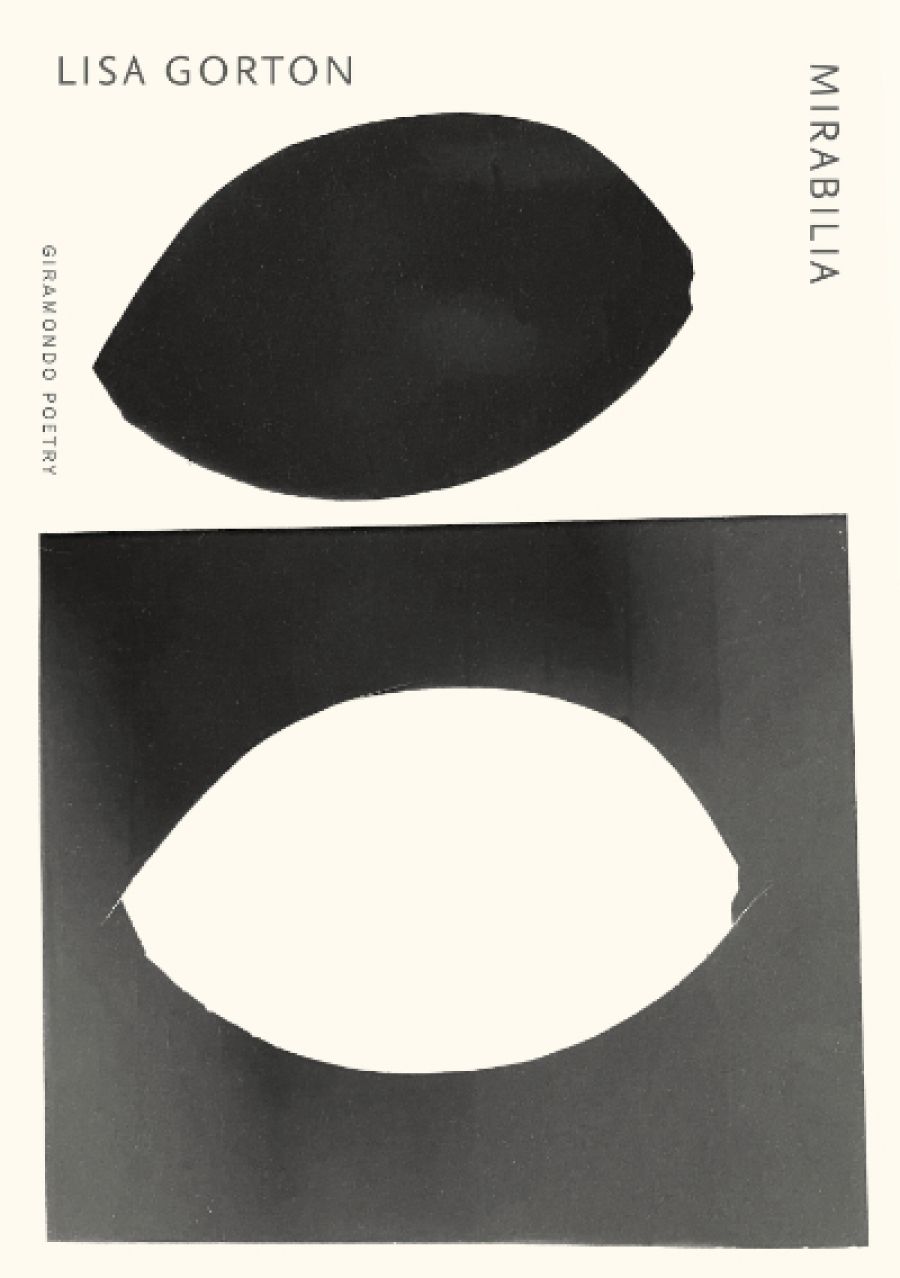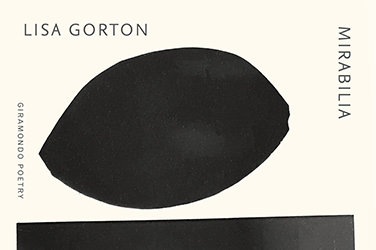
- Free Article: No
- Contents Category: Poetry
- Review Article: Yes
- Article Title: Mordant marvels
- Article Subtitle: A wondrous, disquieting poetry collection
- Online Only: No
- Custom Highlight Text:
Mirabilia is the plural form of the Latin mirabile: wonderful thing, marvel. Since the publication of her first book, Press Release, in 2007, Lisa Gorton has cultivated such a voice in Australian poetry. Mordant political wit, formal and thematic bricolage, a liquid control of the line, and the ability to trace patterns across the strata of history and society – to rove between time and the timeless – have long characterised Gorton’s oeuvre. She showcases the full complement of her gifts in this wondrous and disquieting new collection.
- Article Hero Image (920px wide):

- Article Hero Image Caption: Lisa Gorton (photograph via Giramondo)
- Alt Tag (Article Hero Image): Lisa Gorton (photograph via Giramondo)
- Featured Image (400px * 250px):

- Alt Tag (Featured Image): Anders Villani reviews 'Mirabilia: New poems' by Lisa Gorton
- Book 1 Title: Mirabilia
- Book 1 Subtitle: New poems
- Book 1 Biblio: Giramondo, $25 pb, 85 pp
- Book 1 Readings Link: booktopia.kh4ffx.net/VM3AE
The title poem begins with an epigraph from Marianne Moore’s ‘The Pangolin’: ‘if that which is at all were not forever’. Like Moore’s poem, ‘Mirabilia’ can be read as an ode to what the blurb calls ‘the world’s most-trafficked mammal’, a symbol of endurance amid subjugation, replete with thorough physical and behavioural descriptions. Yet Gorton’s phrasing opens alternate readings: ‘[i]ts tail its counterweight it holds / with hoop-skirt-like up- / rightness’; ‘its armour is not put on—the / snake’s head helmet be- / tween its eyes at its nape outspreads’. What these details intimate is a feminising of the pangolin (later, Gorton will return to ‘the / snake’s head’ as a woman in ‘Medusa’s Mask’). It makes sense, then, that Gorton twice repeats the line ‘its only predator is man’ – not humans, but man. What is more, this reading of ‘Mirabilia’ as a conceit for the treatment of women casts into new light the poem’s cryptic first sentence: ‘It is its / own order.’ In particular, the first line proves both a fragment and a powerful assertion of bodily autonomy, of self-ownership.
If Mirabilia has a central thesis, it is that the patriarchal exploitation of women entails, and precedes, the exploitation of the earth. As a counter-measure, the book embarks on its own wry revisionism, setting the historical record straight on a few key topics. Chief among them is the treatment of women by artists. ‘On the Characterisation of Male Poets’ Mothers’ uses Wikipedia entries to expose the misogyny inherent in the attitudes of Baudelaire, Rimbaud, Rilke, and Larkin towards their mothers, on whom the men were dependent. Consider the parenthetical clarifications in the following quatrain, quoting Rilke:
‘If in my father’s house’
(his father had left)
‘love was shown me with both care and concern only by my father’
(he lived with his mother)
Here, as elsewhere, Rilke overlooks his father’s immense faults yet sees nothing but faults in his mother. Rimbaud’s father, similarly, is ‘good-natured, easy-going, generous’, while he calls his mother ‘his “Mouth of Darkness”’. But it is Rimbaud’s father who abandons him, and Rimbaud’s mother who writes him letters and pays for A Season in Hell to be published. Throughout the poem, Gorton returns to phrases such as ‘it is said’, ‘they say’, and ‘according to reports’ to highlight the impersonal and almost sanctified status of the popular accounts she is calling into question. The result is sardonic and devastating. Here are hypocrisies, mischaracterisations, distortions of history, in the open, yet unseen.
‘The Book of Revelations’ is an ekphrastic poem based on Sidney Nolan’s 1952 photograph Untitled (Cynthia Nolan with Parasol Mounted on Dead Horse). Another withering juxtaposition, the poem interpolates a description of the photograph (google it) with quotations from Nolan and the Book of Revelations, in which four horsemen herald the end of the world. ‘She has clambered onto a dead thing / propped in its litter of bones—’, Gorton writes. ‘She smiles.’ This smile becomes the poem’s fulcrum: ‘I think I know that smile. / A cypher on the face of semi-illiterate rage. / Ashamed of what they’ve asked. Accommodating. / Speech of the dust.’ That the model bears her indignity with a smile, a ‘speech of the dust’, likens her to ‘the dead horse on its hind legs with its / mouth in the dust’. But the day of judgement, Gorton implies, is imminent. This smiling woman is both passive, ascribed the ‘grim elegance’ of a corpse, and the agent of seismic change.
The most challenging of Mirabilia’s three sections is ‘Tongue’, which revolves around the Pazzi conspiracy in Renaissance Florence. In her ‘Notes’, Gorton lists nearly twenty sources for the section’s seven poems. This scholarly density slows the reading experience, pushing one beyond the text for information. Gorton’s use of the em dash, similarly, can make following the syntax difficult, as in the following lines: ‘the one they called Fioretta— / ‘little flower’— / her child one month old / and the child’s father— / they called him ‘Prince of Youth’— / was stabbed at Mass’ (‘Madonna of the Flowers’). Who was stabbed at Mass? In any case, what binds the section is Gorton’s ‘surmise’ that this Fioretta is the model for Leonardo’s Benoit Madonna, painted in the same year as the conspiracy. Political turmoil simmers, empires fissure, great art enters the world, all on the whims of men, while women – the muses, the mothers – find themselves written out of the record. Lorenzo de’ Medici takes Fioretta’s child from her (his murdered brother’s illegitimate child) to spare his family dishonour. The child, Giulio de’ Medici, Gorton tells us, ‘became Pope Clement VII’. In the child’s baptismal register, the mother goes ‘unnamed’. Like the ‘speech of dust’, for another woman, ‘[t]he tongue / in its dark laps air’.
One consequence of this attitude towards women, which erases them from history through silence and artistic idealisation, is the despoiling of nature. The final section of Mirabilia is ‘Great World Atlas’, originally published in the artist Izabela Pluta’s book Figures of Slippage and Isolation. In prose poems named after editions of the Reader’s Digest Great World Atlas, Gorton catalogues historical nuclear testing. This disjunction, between the imperative to map and depict the world and the imperative to render those maps obsolete, proves a ripe subject for Gorton’s distant distancing poetic lens. That lens registers both horror and wonder - an apt awe for our current moment: ‘Between the time of its publication and fourth revise they / exploded the bomb they called Vanya over Novaya Zemlya— / its fireball five miles wide hung a second sun over the / island’ (‘The Readers Digest Great World Atlas 1961 (1962)’). We think, in this extraordinary sequence, to the book’s first epigraph, by Marianne Moore: ‘if that which is at all were not forever’. What if the future were ‘not forever’, yet the past were equally finite, mutable: what alterations to one could improve the other? The preceding sentence in the Moore poem is ‘[t]o explain grace requires / a curious hand’. She might have been thinking of Gorton’s.


Comments powered by CComment